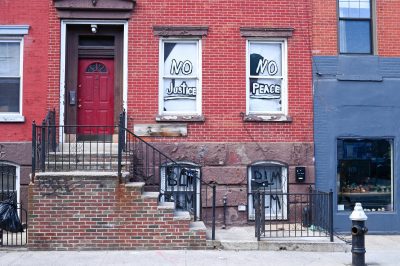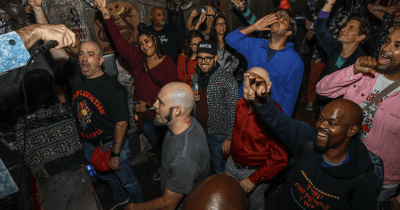Photo illustration by Johansen Peralta
The state of Brooklyn’s small businesses
On the podcast: From microloans to the metaverse, the Brooklyn Chamber of Commerce doesn't look like your grandfather's chamber
Like what you’re hearing? Subscribe to us at iTunes, check us out on Spotify and hear us on Google, Amazon, Stitcher and TuneIn. This is our RSS feed. Tell a friend!
Brooklyn has entered the metaverse.
To be more specific, the Brooklyn Chamber of Commerce has entered the metaverse. Seoul, Korea was by some accounts the first city to establish a virtual communication ecosystem in the so-called metaverse on January 1. But Brooklyn isn’t far behind. Randy Peers, the president and CEO of the Brooklyn Chamber of Commerce singed an international memorandum of understanding with his counterpart in Seoul this month via an Oculus VR headset. Or rather, his avatar did.
“We were doing a virtual product exchange where Seoul had sent some products here, we set them up in Industry City. We sent Brooklyn-made products over to Seoul and then we signed this agreement through the metaverse. Our avatars did,” says Peers. “For me it was extraordinary. I had to practice the day before, because when you put the Oculus on, you have this natural tendency to want to actually physically move, so you want to walk. But you’re in a room and you can bang into desks and stuff like that.”
This, clearly, is not your grandfather’s chamber. And Peers, a lifelong Brooklynite who grew up in Canarsie and lives in Marine Park, will be the first to tell you as much. He is this week’s guest on “Brooklyn Magazine: The Podcast,” where joins us to discuss the 104-year-old chamber as it drags itself into the 21st-century … through a pandemic.
“Brooklyn when I was growing up—‘70s, ‘80s, partially through the ‘90s—was a typical story of an old manufacturing city in decline. Brooklyn was the manufacturing hub for New York City,” he says. “Just after 9/11 was this definitive time when Brooklyn started to turn a corner and march towards this progression of being the hippest, most happening place on the planet.”
That post-war decline of Brooklyn in many ways mirrored that of many rust belt cities, he says. But with its proximity to Manhattan, Brooklyn—rough around the edges as it was—had a few things going for it. “Brooklyn had one very strong advantage It had an identified brand … It was a negative brand at the time but people knew what Brooklyn was,” says Peers. “You have to convince people what was once dangerous became edgy and then ultimately became hip.”
Peers traces that hipness boom to the post-September 11 era, when the borough was able to attract development through real estate conversions (of occasional questionable legal status, perhaps, but that’s a topic for another time). Peers himself took on the mantle of Chamber leadership towards the end of 2019, just months ahead of the pandemic, with the goal of modernizing the body. “Covid hit and there was no playbook for that, but we were able to really kick into action rather quickly and start to reimagine what our value proposition was throughout the crisis,” he says.
That expression, “value proposition,” is an interesting one. What is the role of a century-old chamber of commerce in 2022? Peers himself admits the whole idea of such an organization has a musty feel to it. “You ask a millennial: ‘Tell us about a chamber of commerce,’ they’ll say, ‘Oh yeah, my grandfather worked in finance for 30 years and when he retired and the chamber had a dinner and gave him a watch,’” he says on the podcast. “All chambers do three basic things: promotion, support and advocacy.” Today, the core directive remains, though there is technology they can leverage in new and creative ways. (Hence the metaverse.)
On the podcast we discuss what the industry of tomorrow will be for the borough. “We’ve surpassed San Fransisco in terms of the number of new tech startups. These are small tech startups for the most part,” Peers tells me. “That’s clearly one of the sectors driving the new Brooklyn.” Another sector is healthcare, the largest in the borough by employment.
We discuss his stance on aspects of city infrastructure and how it affects businesses, specifically the dilemma around the crumbling Brooklyn–Queens Expressway (he’d support a thorough re-imagining of the decaying cantilevered roadway); Governor Hochul’s proposal for an interborough railway (he welcomes it), and the Gowanus rezoning (smart, he says).
The chamber, a certified Community Development Financial Institution, or CDFI, has also gotten into lending, which is a new muscle for them. One upshot of the pandemic, he says, has been the ability to grow that CDFI and, as of this writing, dole out some $1.5 million in microloans.
“We never had two nickels to lend before 2020,” he says.
For all of that, and more, check out this episode of “Brooklyn Magazine: The Podcast” for more. Subscribe and listen wherever you get your podcasts.
You might also like 


























